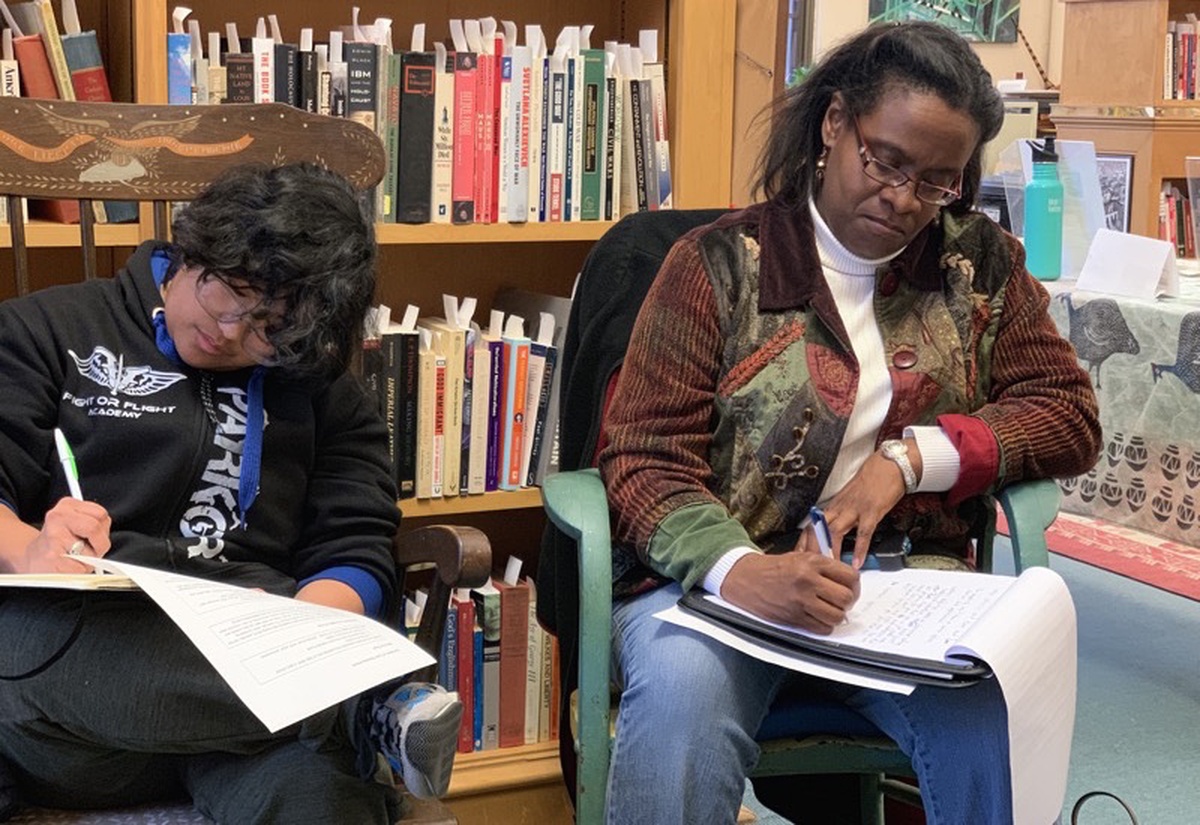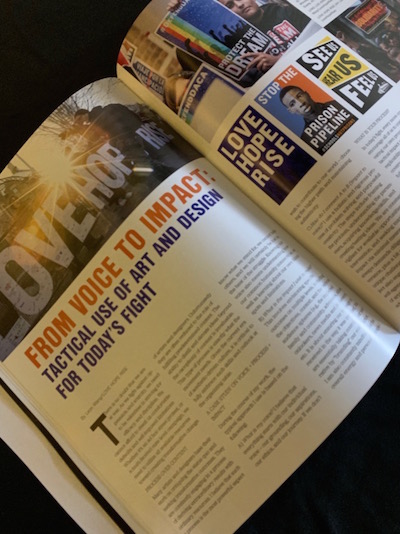Features:
How We Flipped Media Literacy and Built Community Literacy Instead
Our inaugural issue tells a different story of the Minnesota State Legislature.

Following the launch of The Quilt, The UpTake launched a series of community journalism trainings in partnership at the East Side Freedom Library. These free trainings offer an opportunity to begin learning journalism and to pitch stories as part of that learning process.
In the Twin Cities we have no shortage of community media organizations, but we have also fought long and hard against many of our legacy media counterparts. Whether it was Pointergate or so many other injustices, we have struggled to feel that our stories as people of color, as low-income people, as renters, as members of the LGBTQIAP community, etc. are told accurately and fairly.
We have often felt that our identities and issues are dismissed in favor of a false objectivity and in pursuit of a two-sided fallacy, second to word count, editorial planning, traditional journalistic processes and practices, and everything else that is more important than who we are as people.
The Quilt: Policy, Art, and Healing is one way that we’re changing all of that, as we build a community with a different relationship to journalism. It’s an approach rooted in community literacy. Community literacy is often defined as community-based learning and literacy program development. My organization and community define community literacy as “a process in which journalists and other actors understand the processes and roles in which community operates and structures itself.”
Introducing The Quilt: The Short Version
The Quilt is a project of The UpTake and Voices for Racial Justice. It came about after months of discussion and mutual imagining between our two organizations. As two organizations led by people of color from different diasporas, we have had rich conversations about each of our communities’ relationships to policy. Through this we found ourselves sharing stories about local governance models in our various communities, and the lineages of organizing and storytelling embedded in our different cultures.
Our goal, with the inaugural issue of The Quilt, was to tell a different story of the MN State Legislature, and to do so by training community members to be journalists.
The print issue was released Sept. 30. Our original print-run was 1,000 copies with additional copies distributed via PDF. The magazine’s website launches in Dec. 2019 and an additional 1,000 copies are currently being printed and distributed, as well.
At the same time, both our organizations are following up. The UpTake, for example, is launching a year of follow-up reporting, training community members each month to report on specific issues and then paying them as freelance journalists to do so. We are also hosting 1–2 panel discussions each month (livestreamed to our website) on issues introduced or related to The Quilt.
In January, for example, our coverage will largely be focused on Missing and Murdered Indigenous Women. We will host panels and trainings in the Twin Cities and Duluth, and we will launch the month with a story on sex trafficking in Duluth and north to the Canadian border.
You can read more about missing and murdered indigenous women in this story by MN State Rep. Mary Kunesh-Podein.
Other stories you can read in The Quilt include:
Community artist and strategist Leon Wang (LoveHopeRise) discusses the relationship between organizing, art, and strategic planning
LegalAid lawyer Jessica Webster discusses unemployment insurance.
An equity-centered legislative assessment based off of Voices for Racial Justice’ former annual and long-running Racial Equity Report Card.
Our two very distinct organizations came together, because we believe that A) journalism can be done more equitably, B) that policy and art have everything to do with each other, and that C) our community’s voices matter most in these pursuits. We came together to begin building a village, quilting a village based out of our want to see a different world come to be, making use of the tools that we have access to.
The magazine was written primarily by community members and the art and poetry were also, largely, community-sourced. The entire process required that we build a relationship between community members and that we seek invitation into community spaces and community dialogues. In order to do this, we needed to understand who our community is, how they operate, and who we are (and can be) to them.
Weaving The Quilt
The UpTake is a woman of color-led, community-centered nonprofit news organization, founded in 2007. In our earliest years, we were a citizen journalism organization known for our livestream coverage of the Minnesota Legislature; electoral campaigns and recounts; and community mobilization efforts. Today, we are a community journalism organization that centers a deep and continuous analysis of social issues. We seek to serve all under-represented communities in the Twin Cities.
Voices for Racial Justice (VRJ), formerly known as the Organizing Apprenticeship Project, is a people of color-led movement organization. VRJ works to advance racial, cultural, social, and economic justice in Minnesota through organizer and leadership training, strategic convenings and campaigns, and research and policy tools. VRJ envisions a world without racism honoring the culture, knowledge, power, and healing of black, brown, immigrant, and indigenous communities.
To create The Quilt, we combined Voices’ background in creating assessment tools with The UpTake’s editorial knowledge and a Journalism of Color methodology developed by staff at The UpTake with guidance and mentorship from Voices’ staff.
What our Journalism Process Looked Like
1) We asked questions about our own community literacy, and we thought about how we might improve it.
Journalists often discuss media literacy, and that was a big part of this, as community members underwent journalism training in the process of writing for the magazine. But The Quilt required that our own team develop and practice community literacy first-and-foremost. We asked questions like these:
What is my community’s relationship with my organization?
What is my community’s understanding of journalism?
What is my organization’s understanding of community and the role of community in our work?
What is the responsibility of community and community journalism toward each other
We understand that journalism can inflict trauma via its storytelling practices, but we also have a responsibility towards storytelling. What are the ways in which we decolonize journalism or create restorative journalism processes in order to negate that trauma?
What are the roles and structures of community-based, community-led, community-owned journalism?
2) From there, we worked on our own team’s community literacy, not our reader’s media literacy.
For The Quilt, community literacy meant we spent the first several months of the project grabbing coffee with community members, listening to them, and exploring with them their vision for how to tell their story. It required that we spend time building trust and learning from community about their issues, their stories, their tensions, their challenges, before we were ever able to begin the training-and-reporting process and participant’s own learning of media literacy.
It was a process not without its own challenges and tensions. It was something I desperately wanted to hold on to with clenched hands. At the same time, community literacy requires that I trust my community to use the process. For example, there is one story you won’t see in the print issue of The Quilt. There was an issue that I reported on, in conjunction with community members. I felt confident as a reporter in the story, but the co-writer and community leaders impacted by the issue felt that the story was missing critical pieces, and in the end I agreed they were correct. We made the decision to pull the story from the print issue, conduct additional interviews and do additional research, and—eventually—publish the story online. I needed to trust my community to tell me that the story did not work, despite how hard I wanted to hold on to every inch of my editorial independence and my decade of experience in the work. I had to recognize that I did not know more about this injustice and this issue than they did.
It was a decision that is core to how The UpTake and Quilt-makers seek to practice journalism. It’s also core to the journalism methodology guiding the creation of The Quilt.
3) Informed by what we learned, we worked with community members as they practiced Journalism of Color.
Our work at The UpTake is guided by Journalism of Color, a theory of journalism I developed and defined in my doctoral studies and dissertation by the same name at Prescott College. It’s become a way to organize our own relationship with community. And it aims to develop journalism that deconstructs and rethinks the power dynamics between journalism institutions, as well as journalists, and historically-marginalized communities.
Journalism of Color is a community-based journalism methodology that is framed by the values, narratives, and historical contexts of historically-marginalized communities. It emphasizes the following:
Disrupting traditional narratives about historically marginalized communities
Writing for and by historically marginalized communities
Creating journalism, journalism spaces, and journalism tools that are easily accessed by these communities and practiced by these communities
Developing localized journalism structures and processes and community-based journalism and journalistic literacy
Building and translating knowledge of justice and how it comes to be whilst decoding and deconstructing oppression, presenting counter ideologies, and challenging existing ideologies
Constructing authentic community connections through responsiveness, adaptability, accessibility, critical reflection, cooperation, the prioritization of community voices, the articulation of beauty, and mutual trust
Linking trust with analyses of justice and power, while centering community vision and values
Journalism of Color puts the power of journalism into the hands of people who systematically have difficulty accessing journalism, as well as journalism tools and spaces. This idea organizes and builds on the work of the Black and Brown Press, narrative-building practices, theories of power and cooperation, as well as independent journalism, in order to confront and deconstruct hegemony.
Journalism of Color is guided by four principles:
Racism is ideological, systemic, structural, and individual. Its impacts cannot be dismissed.
White hegemony (hegemony is a dominant idea that becomes real via its power) is real and its impacts are lived.
Journalism is absolutely crucial as a tool for resistance, but it is not the only tool, and it cannot happen alone.
Solidarity is intentional. Oppression ties us all together.
Both Journalism of Color and The Quilt are meant to be organizing tools. During our Sept. 30 soft-release we asked community members, those who had participated in the process of creating The Quilt, how we should use the magazine as an organizing tool.
Journalism of Color is largely academic, but—aside from The Quilt—this is what it means when it plays out.
I used to work for North News, the only newspaper serving all of North Minneapolis and only North Minneapolis, as I finished my PhD, and much of what we practiced there impacted how I began to think about what journalism means to people and what it looks like to people who either do not see themselves in the news or don’t see true versions of themselves. As a reporter, the paper’s editor Kenzie O’Keefe made it common practice to review our stories with community members prior to publishing. Often community members would speak with us as interviewees, but they might not understand the journalism process, so quoting them without allowing them to understand our work as journalists was not just a disservice, it was an injustice.
It was our job as the only local paper in the Northside to make sure that people understood the decisions we made and the stories we told and that went beyond the words on the page.
North News also taught two local journalism classes. Our commitment to building a relationship with the community, and an understanding of what we did went right to the classroom. I left that experience transformed as both a journalist and an educator.
That is Journalism of Color. It’s about flipping the power dynamics between who we are as journalists and who our community is, not just allowing them as “inside look,” but actively working with each person to ensure they understand what journalism is and why journalism is. It’s an educational tool, whether it’s education in the classroom or education in the paper, whether it’s who is writing the news or what news is being written.
For The Quilt it meant taking our time to tell a story that does not often get to be told. It meant stepping back and listening to the community and making the hard choices to prioritize their truth over mine or any other Quilt-maker. Simply, The UpTake, Journalism of Color, and The Quilt all say that our communities are the experts of their own story and that we have a responsibility as journalists to understand those stories, and then to act accordingly.
The Quilt is our effort to tell a different story of who are community is and what their story is in a place like the MN State Legislature, where their stories are often lost in favor of people with more (traditional) power than them and more (traditional) knowledge of how journalism works.
In Conclusion
Making The Quilt required some foundational shifts in our journalism, shifts that as as brand-new Executive Director I was terrified to take. Becoming an ED was never something I sought to be. I’m a teacher (teaching community organizing to graduate students and community journalism classes) and a journalist; running a newsroom is a whole different ball game. To take such a drastic left-turn in a newsroom accustomed to a different brand of journalism has taken some getting used to for our organizational leaders and our audience.
And the end result, the published copy of The Quilt, is really just the beginning. Our hope is for this magazine to be a bridge that connects policy, art, and healing to a larger discussion about community transformation. At the same time, the inaugural issue is only the first time people will read The Quilt. Additional issues are planned, as is a year of follow-up reporting, working in partnership with and led by our communities.
I’m inspired by Ricardo Levins Morales, a Twin Cities-based artist-organizer and elder who provided art for the magazine, but has also guided Voices for Racial Justice in their own re-birth. I think about his words when I think about community literacy and the need to tend the soil of my organization’s relationships with community and our own system-deep understanding of who we are, who we serve, and what our purpose is. He says:
“The soil is more important than the seeds. Almost anything will grow in rich, nutritious soil, whereas it’s hard to get anything to grow if the soil is barren and toxic and won’t hold moisture. So the seeds are our projects, our initiatives, our campaigns, our organizations, our institutions, that we want to build and the soil is the compost of beliefs, ideas, values, narratives that create the environment within which we are working.”
I want to push my community to use this tool, to not give up on storytelling and journalism, but to seek restorative journalism and to make use of the opportunity we have in front of us. We cannot abandon our stories and storytelling, because others won’t stop telling them anyway— legislators won’t stop making laws, and businesses won’t stop appropriating and commercializing them. We have to counter that work, and we have the opportunity to do so.
You can contact me at cirien.saadeh@theuptake.org for a PDF of the magazine or to have a print copy mailed to you. Visit us online at www.theuptake.org.

Stories in The Quilt were predominantly written by community members or completed in partnership with community members.

Community members gathered on Sept. 30 for a soft-launch of The Quilt. They were asked to reflect on how we can all best use the tool to build community power and a new vision for journalism.
Credits
-
 Cirien Saadeh
Cirien Saadeh
Dr. Cirien Saadeh (she/her) is a journalist and educator who works at the intersections of journalism, social movements, experiential education, and sustainability. Saadeh is the Executive Director for The UpTake and Associate Faculty at Prescott College where she received her PhD in Sustainability Education in 2019. She has written for local, national, and international publications and is committed to using journalism as a tool in the pursuit of justice for all historically disenfranchised communities.




 2012 in Review: Miranda Mulligan
2012 in Review: Miranda Mulligan